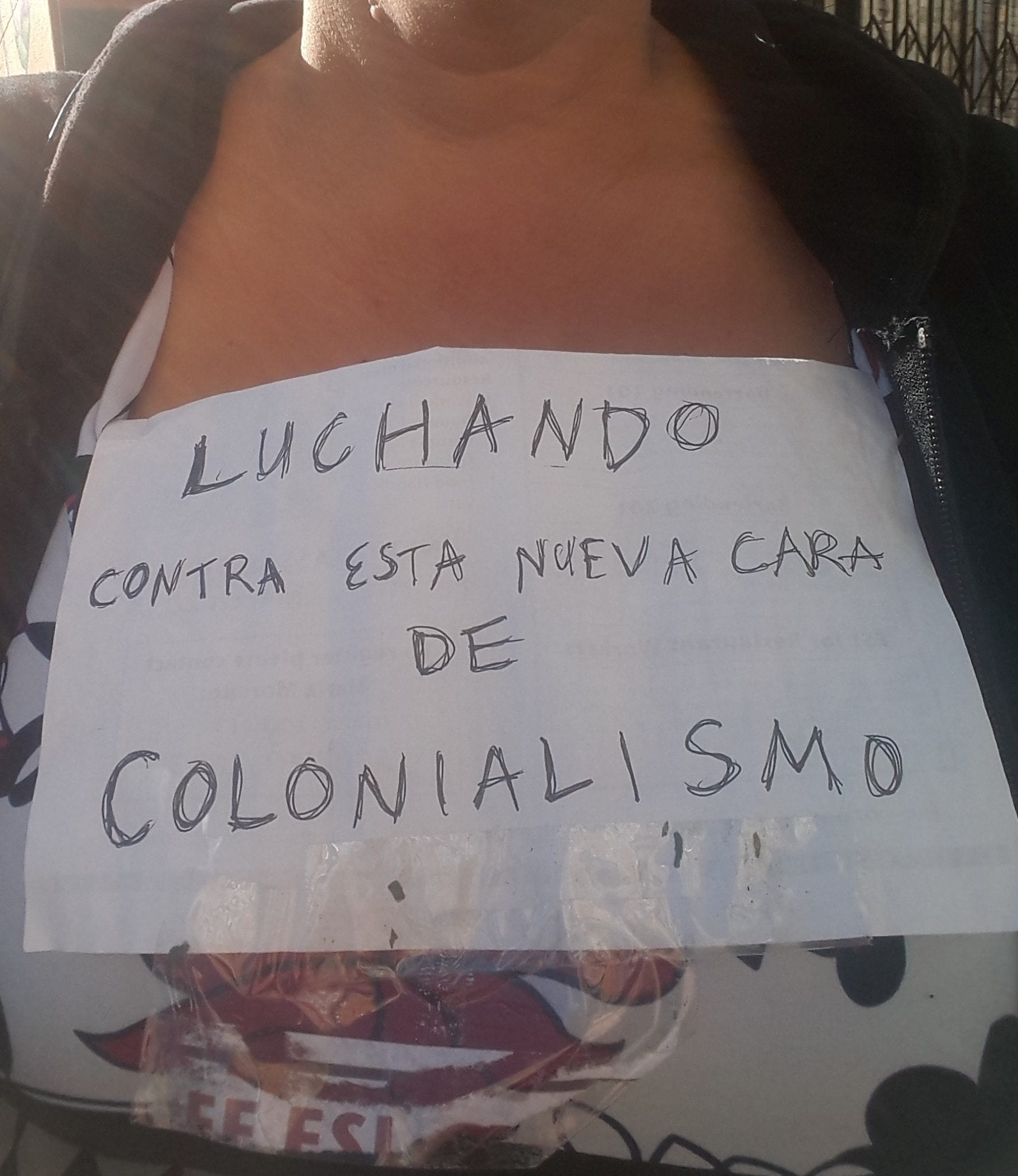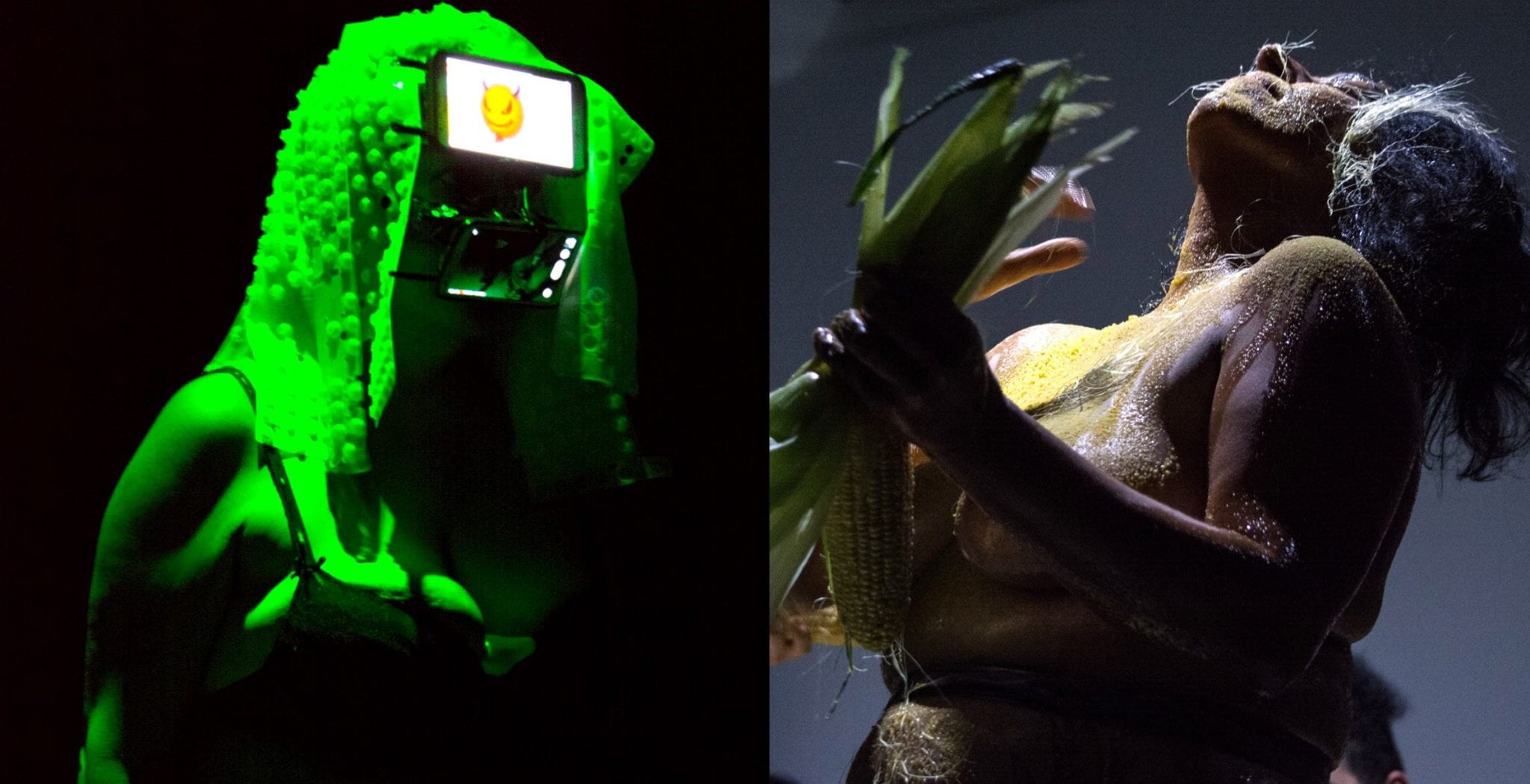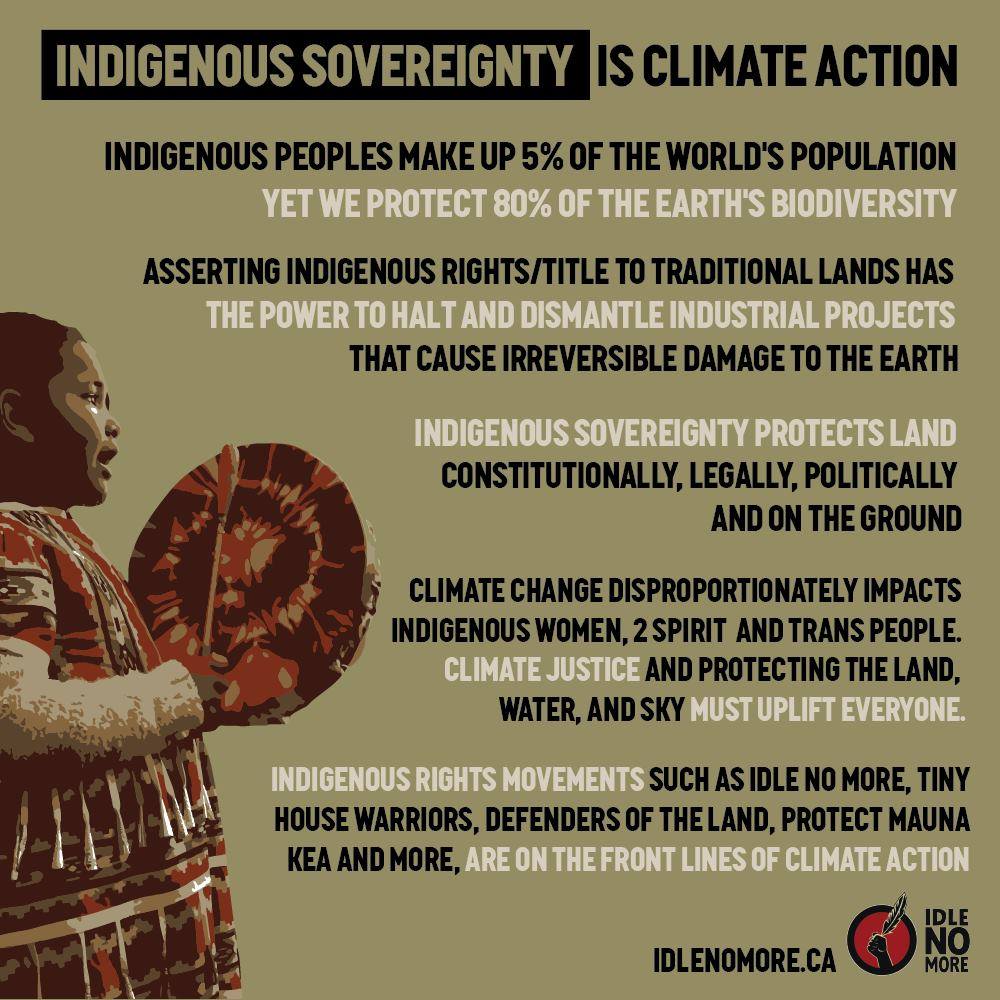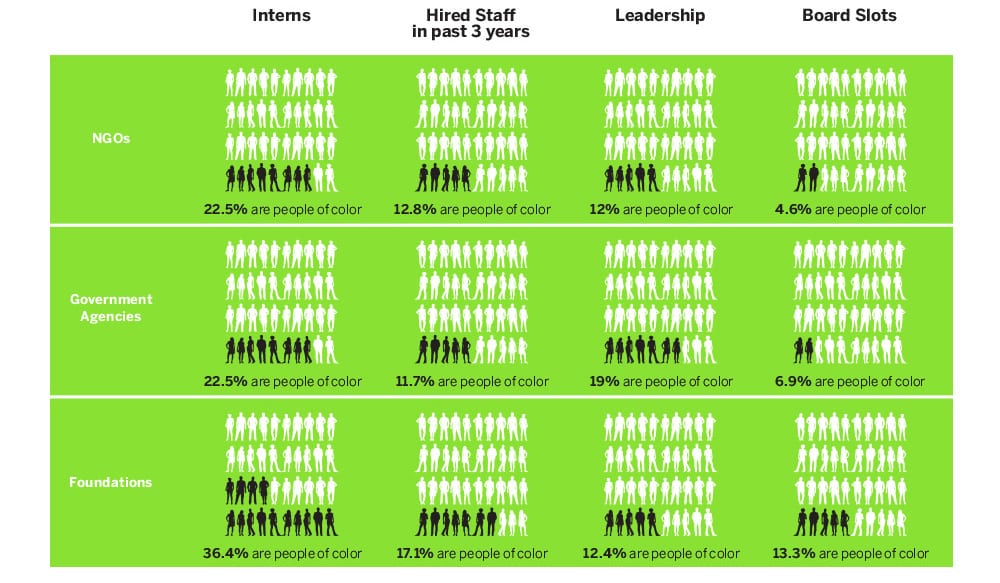Location: Oakland, CA
I HAD ORIGINALLY PLANNED to write commentary highlighting innovative women-identified eco artists who work with technology, from a fascinating international field of practices generating new thoughts, ideas and areas of growth within the environmental movement. However, recent headlines about racism within Extinction Rebellion have forced me to reconsider my topic and instead write about current life and death issues: the popularization of white supremacist ideas in the Global North, the election of white supremacist leaders, and the spread of xenophobia in the environmental movement.

The author at the Global Women’s March, 2018. Photographer anonymous.
In the late 1990s, I was very active in the global campaign fighting the biotechnology giant Monsanto Corporation’s commercialization of seed sterilizing technologies. Seed sterilizing technologies, dubbed “Terminator Tech” by the Rural Advancement Foundation, were threatening the food supply of 1.2 billion farmers. Joining with artists in the San Francisco Bay Area, we founded two art activism organizations, the Hexterminators: SuperHeroes of the Biozoid Age; and Artists for Responsible Genetics, to support the campaign against the spread of this dangerous biotechnology. We also created a website, artactivist.com (no longer active), that not only featured our work but also hosted numerous other art-activist groups. I previously wrote about this work in the No Time For Complacency issue of this magazine.
I mention this history because it was in this capacity that I was approached by the Political Ecology Group to join the Greening of Hate campaign of the late 1990s. Briefly, the Greening of Hate campaign contested the Sierra Club’s ‘Comprehensive Population Policy’, which advocated for the reduction of immigrants in the U.S. The Sierra Club was scapegoating immigrants (rather than polluting corporations) for environmental damage across the United States. While this policy was going to vote by the national Sierra Club membership, immigrants were depicted as ignorant breeders who would overrun the open space valued by environmentalists.(1) The Southern Poverty Law Center subsequently researched the ‘greening of hate’, and published the exposé Greenwash: Nativists, Environmentalism and the Hypocrisy of Hate (2) detailing how white supremacists had successfully infiltrated the Sierra Club and other environmental organizations.
I. THE EXTRACTOCENE
IN MY ART PRACTICE, publications, and workshops, I trace throughlines from the colonization of the Americas to present-day surveillance capitalism. I am from Colombia and have lived all over the Americas. For personal and political reasons, I have been researching the impacts of colonization on our hemisphere for most of my life.
I use the term Extractocene to describe our current geological era to draw attention to the mentality of extraction that Europeans spread around the globe. An extraction mindset sees any resource – whether people, animals, land, water systems, mountains, petroleum, gold, or minerals – as an opportunity for exploitation, regardless of critical interdependent relations that put life at risk. I do not use the term Anthropocene because it does not acknowledge the extreme asymmetries in how humans have contributed to global land degradation, habitat loss, ocean acidification, biodiversity decline, pollinator loss, freshwater shortages, warming, heatwaves, precipitation, drought, floods, fires, storms, and other massive present day signs of ecological collapse and climate change.

I lecture and teach workshops on the Extractocene that connect colonial extraction to the data mining practices of technology corporations of surveillance capitalism, where extraction focuses on humans as data points. I call this the Necro-Techno Complex,(3) through my interpretation of Achille Mbembe’s Necropolitics, and Tonya Gonnella Frichner’s Frameworks of Dominance. To speak to the factory that predates the industrial revolution, Mbembe quotes Fanon: Colonialism is a factory where madness is manufactured. Colonialism’s madness-manufacturing factory is now run by technology corporations, extraction industries, developers, repressive states, drug cartels, criminal syndicates – all one and the same. The Necro-Techno Complex has further automated our eviction from the biosphere into an alienated world of surveillance and social technologies that provide a commodified simulacra of experiences, relationships, pleasures and desires.
Part of my art practice is decoding how technology corporations have seized biopower from modern states, obliterated sovereignty, and intensified the commodification of human existence through a necropolitical simulacra that is orders of magnitude larger than us. In my performances, including the NO!!!BOT and The Techno-Tamaladas, I seek to co-create temporary utopias beyond this framework with audiences and publics.

Praba Pilar, The NO!!!BOT. Vancouver Live Biennale, 2017. Photographs by Ash Tanasiychuk.
II. GLOBAL CLIMATE COOLED 1.5 °C AROUND THE YEAR 1600
HUMAN CAUSED CLIMATE CHANGE has already happened on our planet. During the colonization of the hemisphere of the Americas, nearly 60 million Indigenous people were killed. This colonial genocide so devastated populations between 1492 and 1610, that much of the lands on which Indigenous people had lived on were depopulated and, as a result, were reforested. This, in turn, decreased carbon dioxide (CO2) in the global atmosphere and by 1610, global temperatures had decreased an estimated 1.5 °C. While past researchers have attributed this episode of global cooling to other factors, results published by scientists at the University College London in 2019 from the study Earth system impacts of the European arrival and Great Dying in the Americas after 1492 (4) show how this happened. In the BBC podcast A Genocide-Generated Drop in Carbon Dioxide below, study authors Mark Maslin and Chris Brierley discuss how the colonization of the Americas not only caused global climate change, but was the start of global genocide, global capitalism, and the globalization of slavery. (5)
Lest one think this depopulation was caused by disease, historian Andrés Reséndez has meticulously traced cases of smallpox and other illnesses in settled areas. In The Other Slavery: The Uncovered Story of Indian Enslavement in America (6), he argues that it was slavery, not disease, that decimated Indigenous populations in the Americas. Although by 1542 the Spanish crown had formally prohibited slavery of Indigenous populations, Reséndez details extra-legal forms of slavery that were then instituted and carried out, such as encomiendas, repartimientos, and convict labor, which are very difficult to eradicate and remain with us to this day.
III. THE ANGRY INUK
THIS BRINGS TO ME AN artist whose work reflects very clearly how sectors of the environmental movement exhibit colonialist mindsets, and effect racist violence in unexpected ways. In her film The Angry Inuk, Inuit filmmaker and #sealfie inventor Alethea Arnaquq-Baril exposes the colonialism underlying the anti-sealing campaigns of Greenpeace and other animal welfare groups. In the film, made over eight years, Arnaquq-Baril and members of her Inuit community present a convincing argument that seal hunting is crucial to Inuit survival, and describe how environmental and animal rights groups have misrepresented the seal hunt to manipulate public opinion and solicit donations. These campaigns have had devastating economic and cultural impacts on Inuit communities.
Angry Inuk (Trailer) from NFB/marketing on Vimeo.
Inuit have always depended on the seal hunt, engaging in sustainable subsistence hunting prior to colonization and today relying on the hunt both for food and for hides that can be marketed and enable them to survive in the cash economy imposed with the State of Canada’s occupation of their traditional lands and waters. As Arnaquq-Baril explains:
Well, I mean we didn’t live on a cash economy before contact with Europeans, although there was still trade among Inuit and First Nations, but about 100 years ago, Inuit started trading with The Hudson’s Bay Company and whalers and that kind of thing. When the Inuit were forced off the land and into permanent settlements throughout the 1950s and 1960s, because the Canadian government wanted Inuit to be settled so that we could lay claim to the Arctic for Canada for sovereignty purposes, when we became settled into communities, suddenly we had to pay rent and buy things and pay for fuel, things that we never had to before. In the 1950s and 1960s when anti-sealing campaigns started was right around the same time we became very dependent on a cash livelihood. (7)
Since the 1960s, the International Fund for Animal Welfare, Greenpeace and other environmental and animal rights groups took on seal hunting as a major international campaign, fundraising and devoting resources to end the hunts. By 1983, they had been able to effect a ban on the sale of white-coat harp pup seals skins in the EU. Inuit hunt either ring or harp adult seals, not pups. However, with the introduction of the ban (which included a clause supporting Inuit subsistence hunting), the entire sealskin market immediately crashed. Arnaquq-Baril shows repeatedly that this clause does not affect the survival of Inuit people. It only obfuscates that the Inuit need to be able to operate in a cash economy, and have very few options as shipping from the area is prohibitively expensive. Arnaquq-Baril describes the wider impact of the EU ban on her community:
AMT: Alethea, what was the wider impact of that EU ban?
ALETHEA ARNAQUQ-BARIL: People went hungry. A lot of people went hungry and that clip [from the film] always make me a little emotional because there are so many government initiatives that tried to force Inuit off the land into communities. Tens of thousands of sled dogs were shot so that Inuit couldn’t live independently on the land anymore. Children were taken away and put into residential schools.
For example, in Resolute Bay, I saw a statistic saying that average incomes went from $50,000 that year to the very next year after the ban, it went down to $1,000, so it was devastating. (8)
As reflected in the film, the ban caused many deaths in Inuit communities. By using and popularizing images of white-coat harp pup seals, which the Inuit do not even hunt, environmental and animal rights groups were able to garner support across the world. These images became their most effective fundraising tool, regardless of the fact that they were a disinformation campaign against the Inuit. Inuit communities have been fighting the ban ever since.
In 2014, new Executive Director Joanna Kerr of Greenpeace Canada offered an apology for the impacts of the Greenpeace anti-sealing campaign on Inuit communities. (9) In the apology, Kerr states that Greenpeace continues to support Inuit subsistence hunting, and does not address their need to sell in the commercial seal market for their survival in the Canadian cash economy. In this apology, Kerr redoes the same violence, with a profound cynicism. She does not apologize for years of successful fundraising on the backs of Inuit people. The Inuit lawyer and community member Aaju Peter, who is very involved in the work to undo the ban, argues that, rather than an apology, Greenpeace should be engaged in monetary restitution to the Inuit. (10)
Greenpeace and other environmental and animal rights groups have always had the option to deeply and meaningfully engage with Inuit hunters and communities. Inuit have far fewer choices. At a practical level, the EU ban and the resultant crash in the market for sealskin leaves resource extraction (which actually is ecologically destructive and endangers both humans and animals) as one of the few ways in which Inuit might be able to survive in an imposed cash economy.
IV. CO2OLONIALISM

Indigenous Sovereignty Is Climate Action. Idle No More. Used with permission.
AT LEAST THREE LAND and environmental defenders were killed each week in 2018. Global Witness has documented this in their meticulously researched 2019 report Enemies of the State. (11) Beyond the three murders every week, Global Witness documents how many more Indigenous, Afro-descended, and Global South environmental defenders and others on the frontlines of land and water protection are subject to brutal violence, arrests, attacks and intimidation. The highest rates of murder and violence were found in the Philippines, Colombia, India, Brazil, and Guatemala.
Keeping this in mind, I turn to the London Climate March in England of December, 2015. For months leading up to this action, the Wretched of the Earth bloc, made up of frontline communities, organized behind the scenes to lead the march. The bloc had invited Indigenous delegates from the Sami Nation in Sweden, and from the Pacific Islands, to join them.
The Wretched of the Earth bloc derived its name directly from the title of Franz Fanon’s book. It’s membership consists Indigenous people and people descended from communities from the Global South and includes the Algeria Solidarity Campaign, Argentina Solidarity Campaign, Black Dissidents, Colombia Solidarity Campaign, Environmental Justice North Africa, Global Afrikan People’s Parliament, Global Justice Forum, Indigenous Environmental Network, Kilombo U.K, London Mexico Solidarity, Movimiento Ecuador Reino Unido (MERU), Movimiento Jaguar Despierto, PARCOE, The London Latinxs, South Asia Solidarity Group, This Changes Everything UK and In solidarity: UK Tar Sands Network.
The bloc’s goals are best expressed in their video:
When the Wretched of the Earth bloc arrived at the London Climate march to lead with the banner ‘Still Fighting Co2onialism: Your Climate Profits Kill,’ they found they had been replaced. March organizers had independently decided that people dressed in cute and inoffensive animal costumes should lead the march:
Our place had been given to a group of people dressed in animal headgear. After having invited the Pacific Island and Sami people to lead the bloc, you then took away the main banner of the march and asked them to hold signs instead. The banners made by indigenous communities were covered up. Signs that proclaimed indigenous and global south communities as the ‘Wretched of the Earth’ and charged ‘British Imperialism causes climate injustice’ were to be removed in favor of those that projected a more ‘positive message’. (12)
The bloc refused to be displaced. They went to the front, led the march, and held sit-ins and die-ins. In response, London-based climate activists who had organized the march summoned the police to contain the Wretched of the Earth bloc climate activists:
At various points during the march you called the police on us: first by complaining that the coffins we carried to commemorate the victims of environmental and climate genocide were a health hazard. Later, you called on them to kettle us during a brief die-in near BP’s headquarters so that the rest of the march could continue uninterrupted.
In case you missed it: you, the organisers of the climate march, called on the official agents of colonial and capitalist power to separate indigenous, black, and brown people from the march, portraying us as protesters against the march rather than frontline community members and soldiers for climate justice. (13)
V. THE ENVIRONMENTAL MOVEMENT HAS ALWAYS HAD A RACE PROBLEM
RACISM WITHIN THE ENVIRONMENTAL movement has led to the development and popularization of terms to describe it, such as ‘apartheid ecology,’ ‘green ceiling,’ ‘the unsustainable whiteness of green,’ ‘the green insiders club,’ and others. The deeper history of the environmental movement is full of racist ideas, dreams, language, action, and alliances, including active support for eugenics, population control, violence against Indigenous and Afro descended bodies, immigrant bashing, and many more acts of violence that I cannot detail in this short article. To learn more about this history, a good place to start is with the Southern Poverty Law Center’s Greenwash: Nativists, Environmentalism and the Hypocrisy of Hate, (14) and Jedediah Purdy’s Environmentalism’s Racist History. (15)
Today, this history is reflected in the membership and staff of environmental organizations and foundations. Drawing on confidential interviews with environmental leadership, Green 2.0 (formerly the Green Diversity Initiative) notes that environmental organizations and agencies have not yet broken the ‘green ceiling,’ that unconscious bias hampers recruitment and retention of people of color, and that there is a general disinterest in attracting and working with people of color.

Unconscious Bias, Discrimination, and Insular Recruiting, Image by Green 2.0, formerly the Green Diversity Initiative.
VI. CLIMATE ACTIVISM IS INDIGENOUS SOVEREIGNTY IS CLIMATE JUSTICE IS BLACK LIVES MATTER IS CLIMATE MIGRANT JUSTICE
THERE REMAINS A SEGMENT of the environmental movement that does not understand that people are part of the environment; that climate catastrophe is not a future event, but a past and present one; that ecological collapse has already destroyed lives across the Global South; and that social and political injustice are at the core of environmental issues. As an increasingly xenophobic and racist brand of politics is gaining strength, we in the movement, through the organizations and foundations we work with, must accelerate the shift from climate action to climate justice.
To create the truly global collective action urgently needed now, environmentalists of the Global North must be accountable. As individuals and organizations, we must take effective action against colonialism or racism every time we encounter or witness it. Environmental sociologist Dorceta E. Taylor explains how to address these urgent issues in a 2018 interview How Green Groups Became So White and What to Do About It. (16) Taylor has developed concrete recommendations to diversify organizations and leadership that include tracking and transparency, accountability, changing resources and funding, engaging diverse constituents and recruiting a diverse board. There are detailed in the publications The Challenge, Leaking Talent: How People of Color are Pushed Out of Environmental Organizations, and Beyond Diversity: A Roadmap to Building an Inclusive Organization. (17)
Climate activism is Indigenous Sovereignty, is Climate Justice, is Black Lives Matter, is Climate Migrant Justice, is Idle No More, is Black Lives Matter, is We ACT for Environmental Justice, is Berta Caceres, is #SAYHERNAME, is Earth Guardians.
This is how we can make the shift from climate action to climate justice happen.
ENDNOTES
(1) This definition of immigrants as breeders, from the era of the campaign, can still be found online. Here is how it is laid out by a supporter of the Sierra Club attack on immigrants: ‘This is a very serious issue for those of us who are struggling to protect our open space, etc.. Immigrants and their descendants have accounted for 60% of our population growth since 1970. We receive over a million newcomers each year – most of whom can begin reproducing immediately and generally have higher birth rates than the native-born. If we had kept immigration levels at their pre-1970’s level of under 200,000 a year, we would have stabilized at 247 million in 2035.’ https://www.susps.org/ibq1998/opinion/anon_9803.html
(2) Greenwash: Nativists, Environmentalism and the Hypocrisy of Hate. Southern Poverty Law Center. July 10, 2010. https://www.splcenter.org/20100630/greenwash-nativists-environmentalism-and-hypocrisy-hate
(3) Situating the Web of the Necro-Techno Complex: The Church of Nano Bio Info Cogno. Praba Pilar. Performance, Religion, and Spirituality (PRS), Vol. 1, Issue 1, ‘Spiritual and Religious Performances of Activism and Protest.’ at https://www.utdl.edu/ojs/index.php/prs/article/view/190
(4) Earth system impacts of the European arrival and Great Dying in the Americas after 1492. Alexander Koch, Chris Brierley, Mark M. Maslin, Simon L. Lewis. Quaternary Science Reviews, Volume 207, p. 13-36. https://www.sciencedirect.com/science/article/pii/S0277379118307261?via%3Dihub
(5) America colonisation ‘cooled Earth’s climate’. Jonathan Amos. BBC Science. 31 January 2019. https://www.bbc.com/news/science-environment-47063973
(6) The Other Slavery: The Uncovered Story of Indian Enslavement in America. Andrés Reséndez. Houghton Mifflin Harcourt: 2016
(7) “Angry Inuk’ argues anti-seal hunt campaign hurts Canadian Inuit life.” Anna Maria Tremonti with guests: Alethea Arnaquq-Baril, Sheryl Fink. The Current, CBC, May 4, 2016. https://www.cbc.ca/radio/thecurrent/the-current-for-may-4-2016-1.3565645/may-4-2016-full-episode-transcript-1.3566881#segment3
(8) ibid
(9) Greenpeace apology to Inuit for impacts of seal campaign. Joanna Kerr. Greenpeace. 24 June, 2014. https://www.greenpeace.org/canada/en/story/5473/greenpeace-apology-to-inuit-for-impacts-of-seal-campaign/
(10) Greenpeace should compensate Inuit for effects of anti-sealing campaign, says activist. Kieran Oudshoorn. CBC News. Dec 01, 2016. https://www.cbc.ca/news/canada/north/greenpeace-should-compensate-over-anti-sealing-campaign-says-activist-1.3875701
(11) Enemies of the State? How governments and businesses silence land and environmental defenders. Global Witness. July 30, 2019. https://www.globalwitness.org/documents/19766/Enemies_of_the_State.pdf
(12) Open Letter from the Wretched of the Earth bloc to the organisers of the People’s Climate March of Justice and Jobs. https://blackdissidents.wordpress.com/2015/12/16/open-letter-from-the-wretched-of-the-earth-bloc-to-the-organisers-of-the-peoples-climate-march-of-justice-and-jobs/
(13) ibid.
(14) Southern Poverty Law Center. Greenwash: Nativists, Environmentalism and the Hypocrisy of Hate. July 10, 2010. https://www.splcenter.org/20100630/greenwash-nativists-environmentalism-and-hypocrisy-hate
(15) Environmentalism’s Racist History, by Jedediah Purdy. The New Yorker, August 13, 2005. https://www.newyorker.com/news/news-desk/environmentalisms-racist-history
(16) How Green Groups Became So White and What to Do About It. Interview with Dorceta Taylor by Diane Toomey. Yale Environment 360. June 21, 2018. https://e360.yale.edu/features/how-green-groups-became-so-white-and-what-to-do-about-it
(17) All Green 2.0 reports available at https://www.diversegreen.org.
